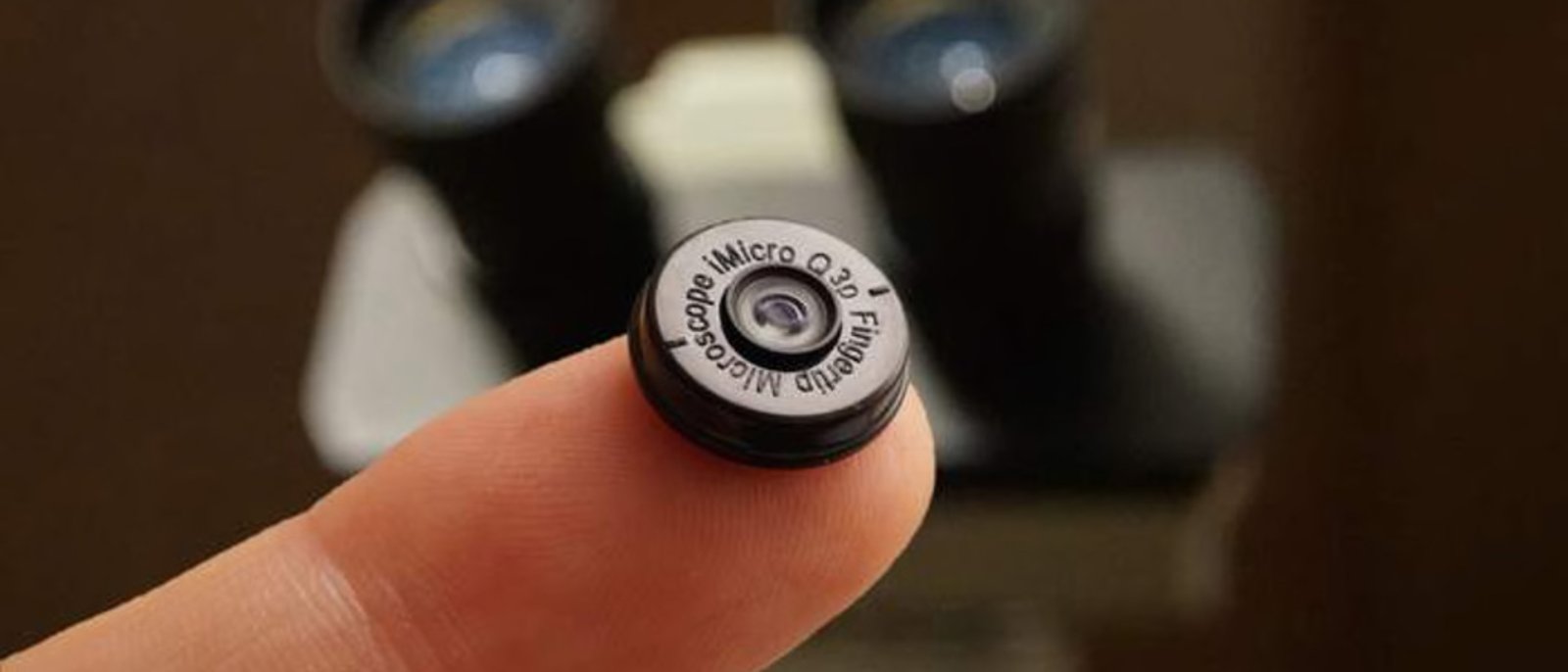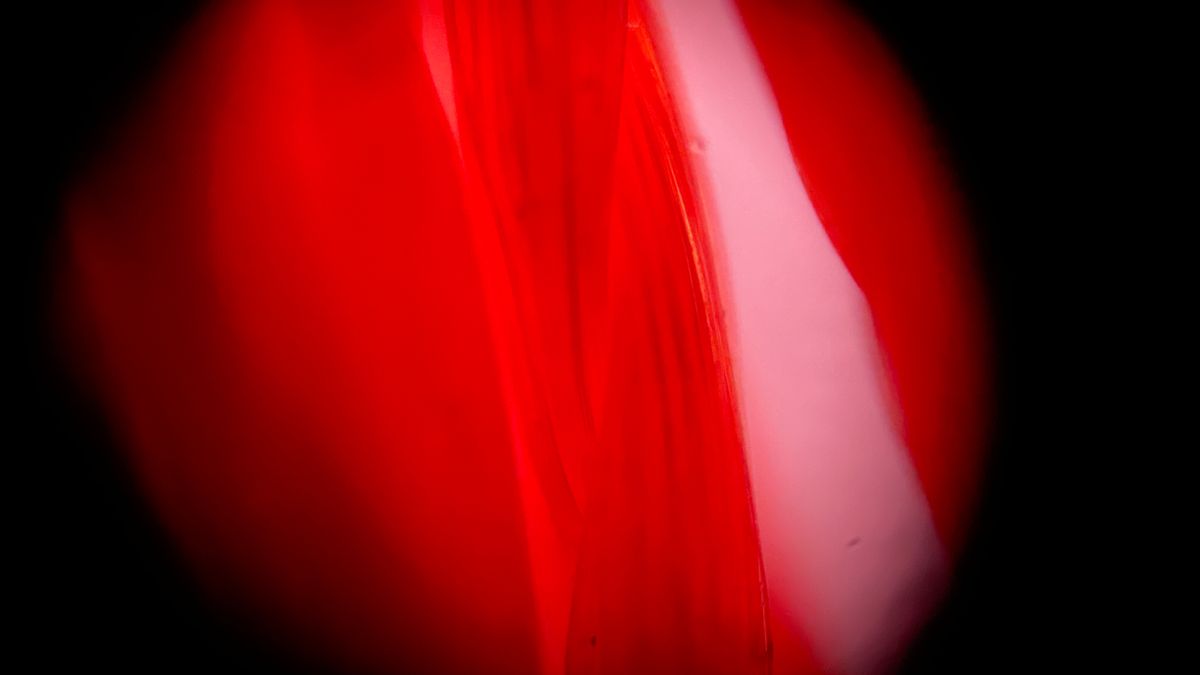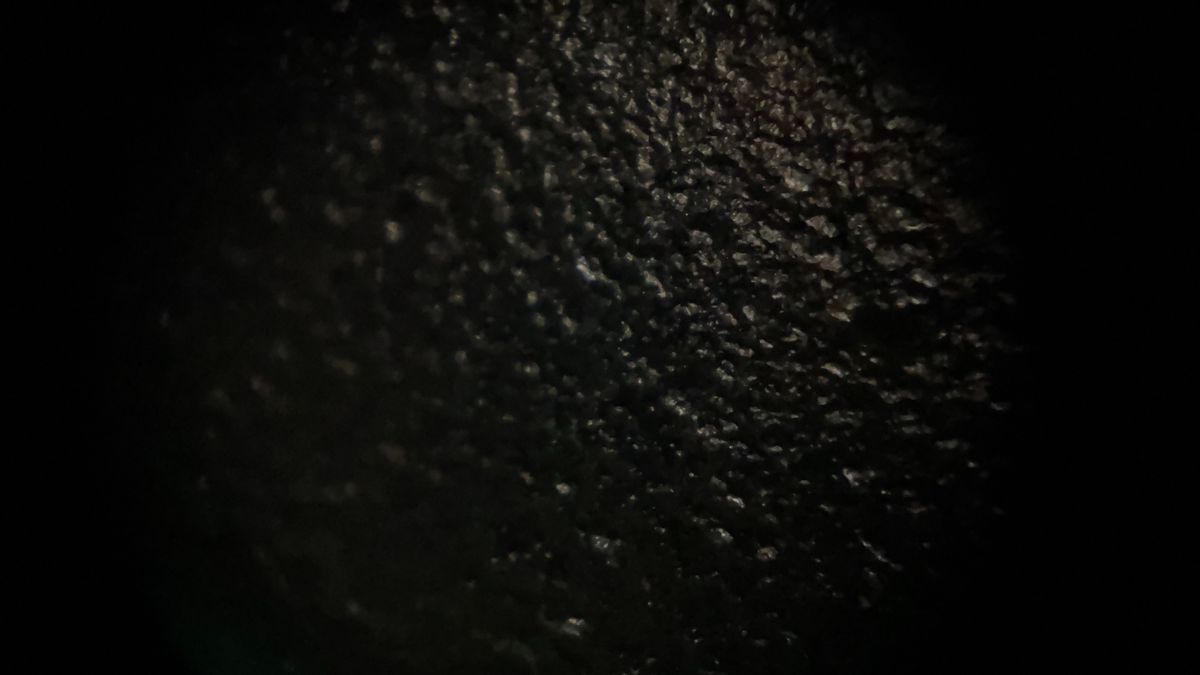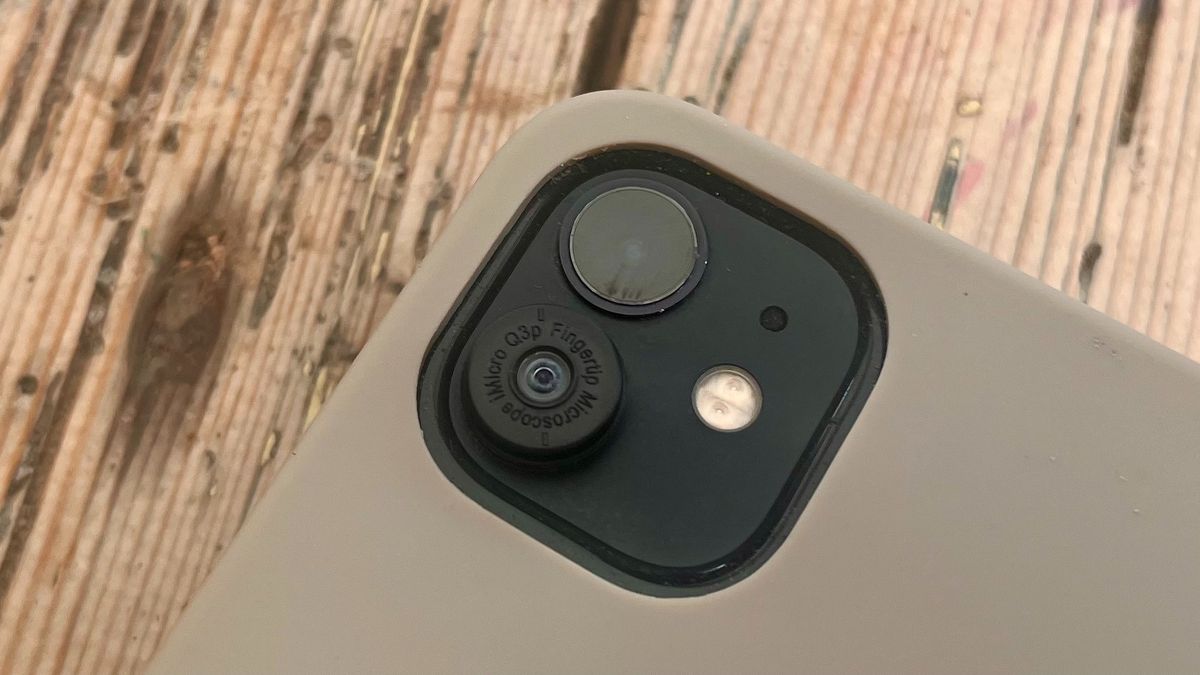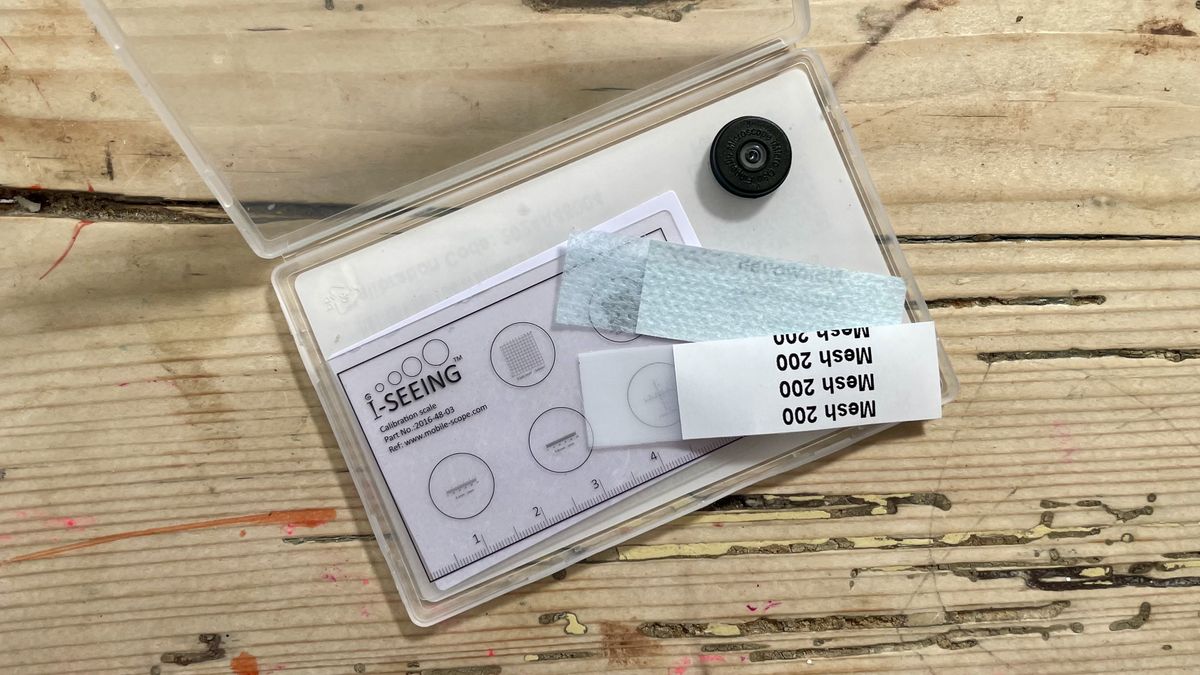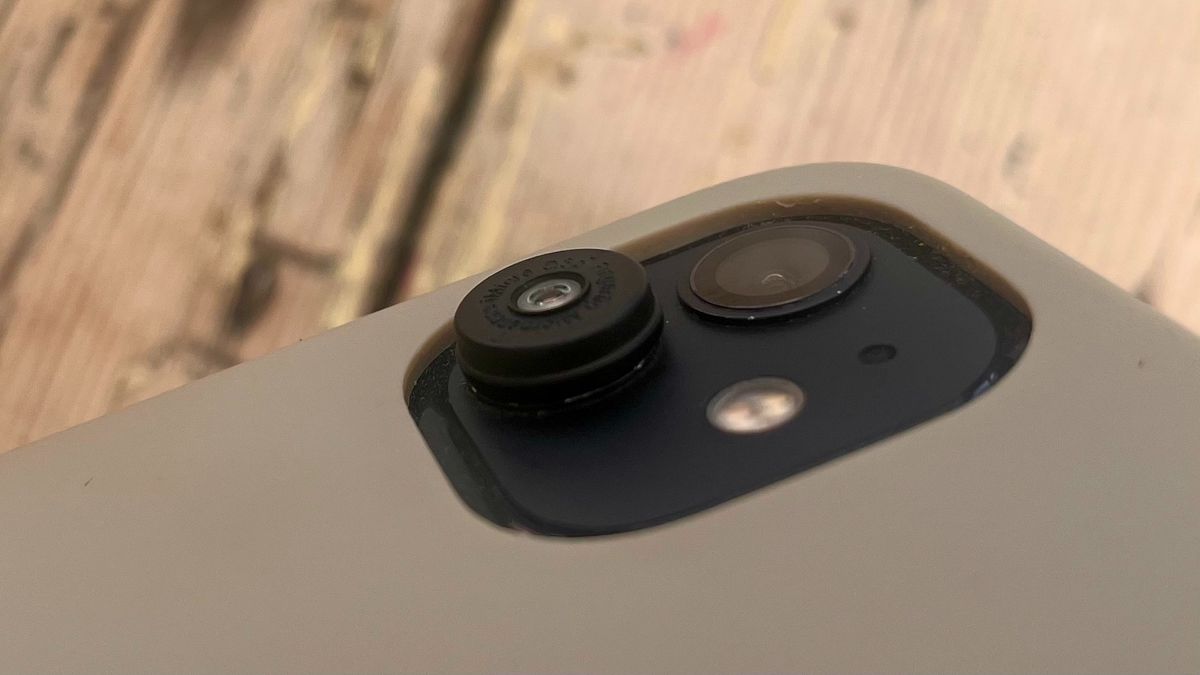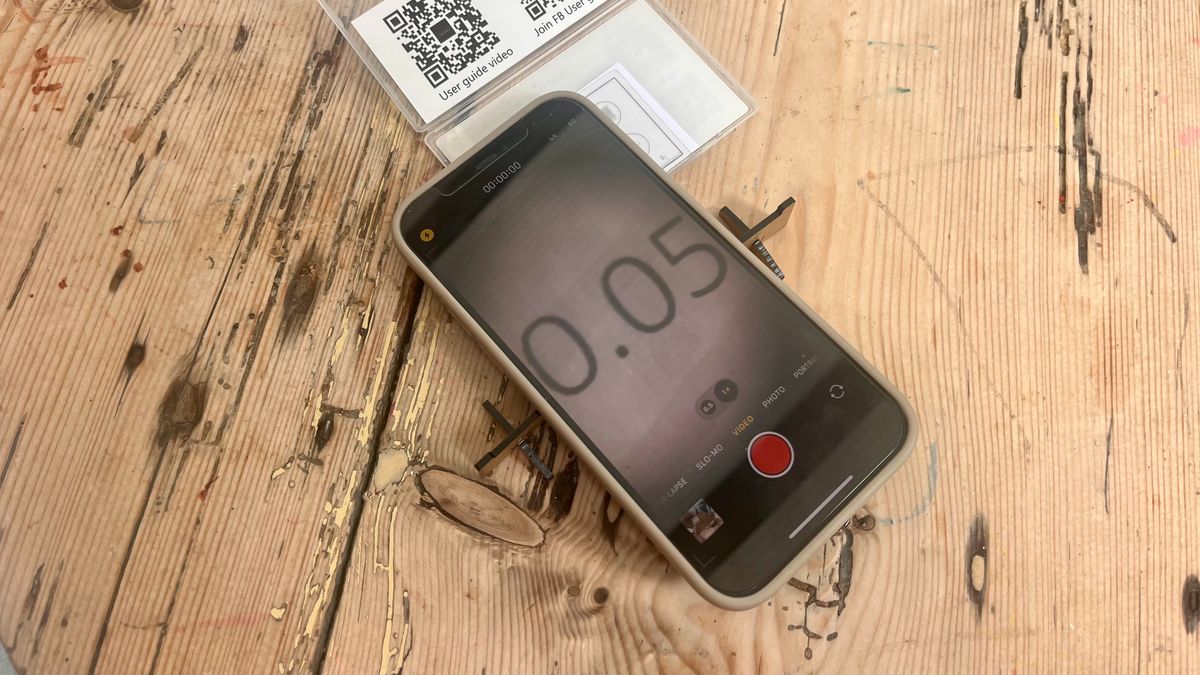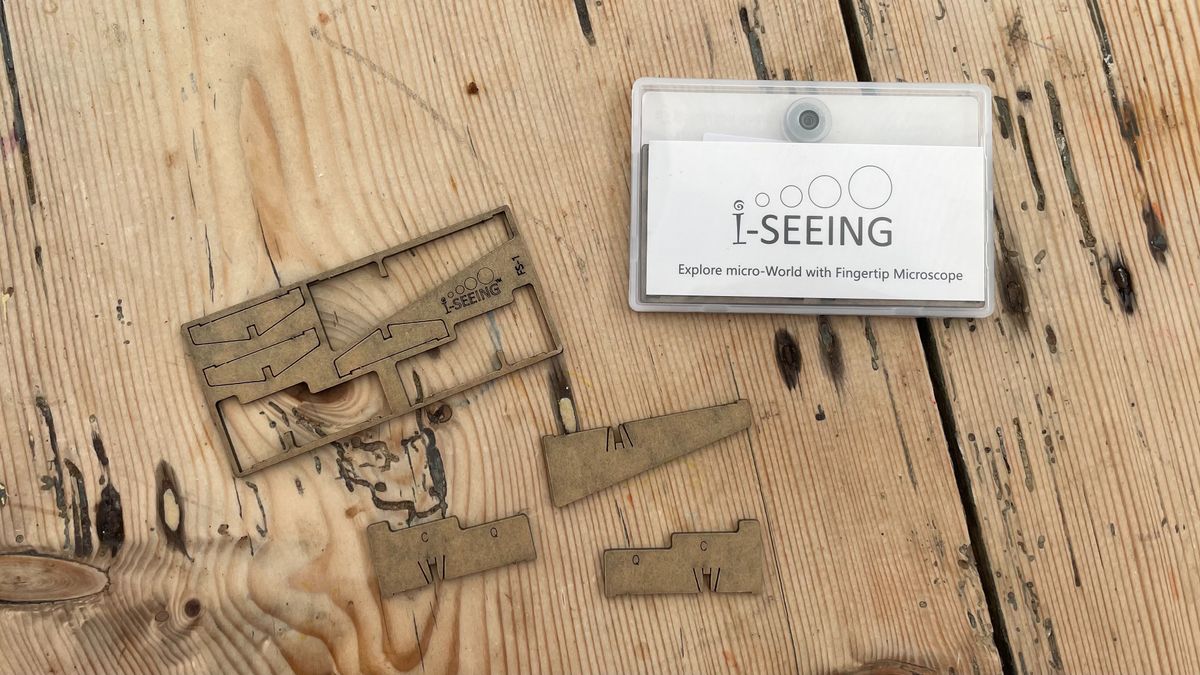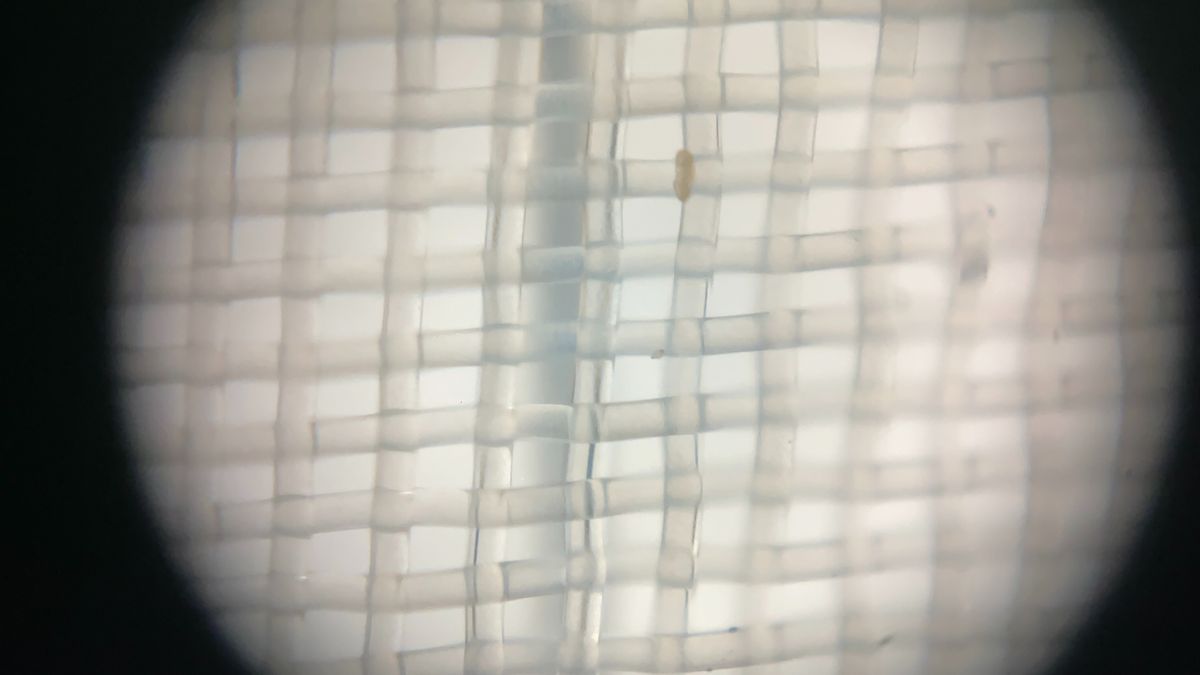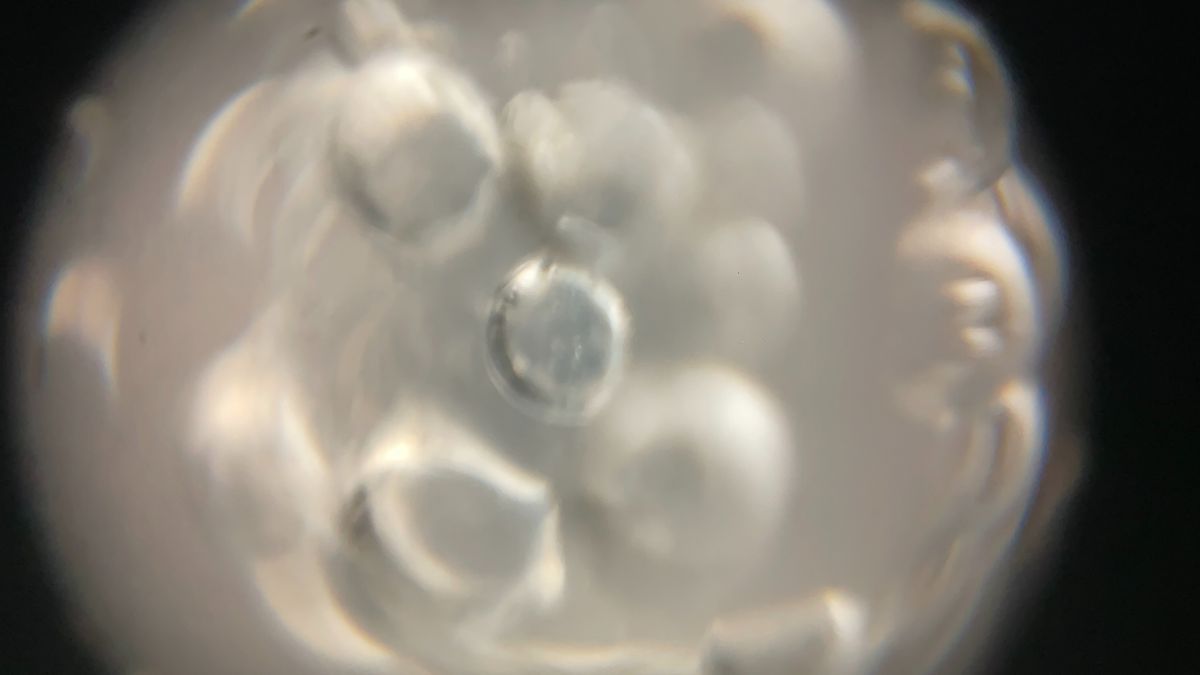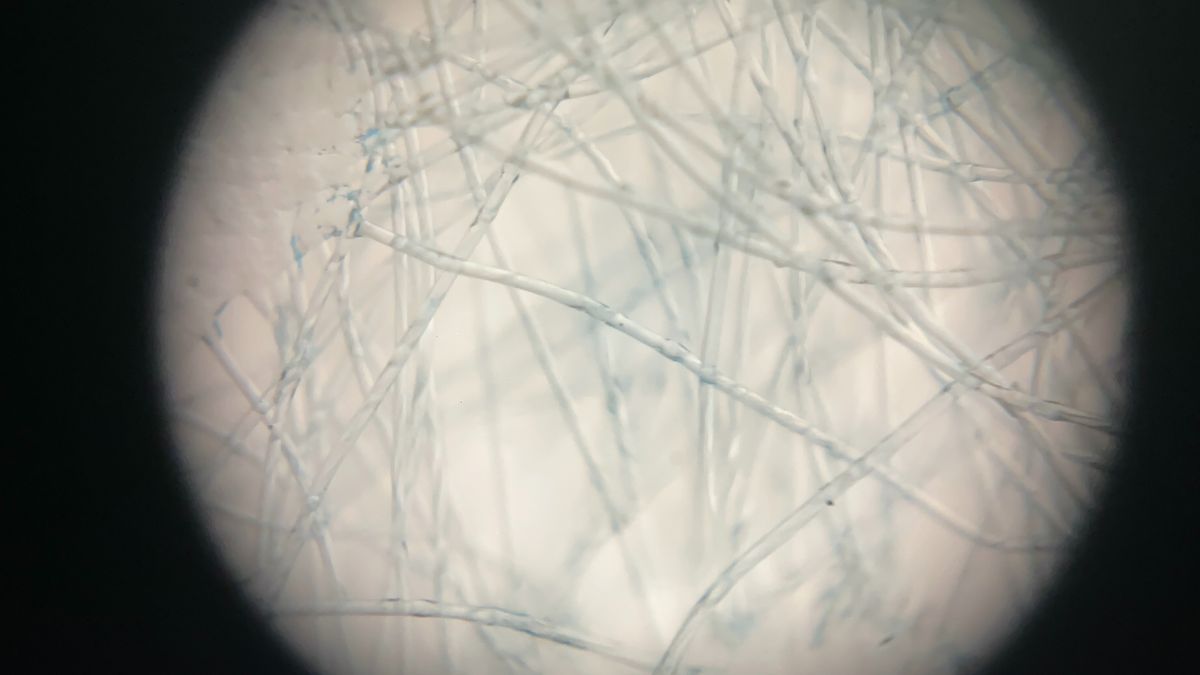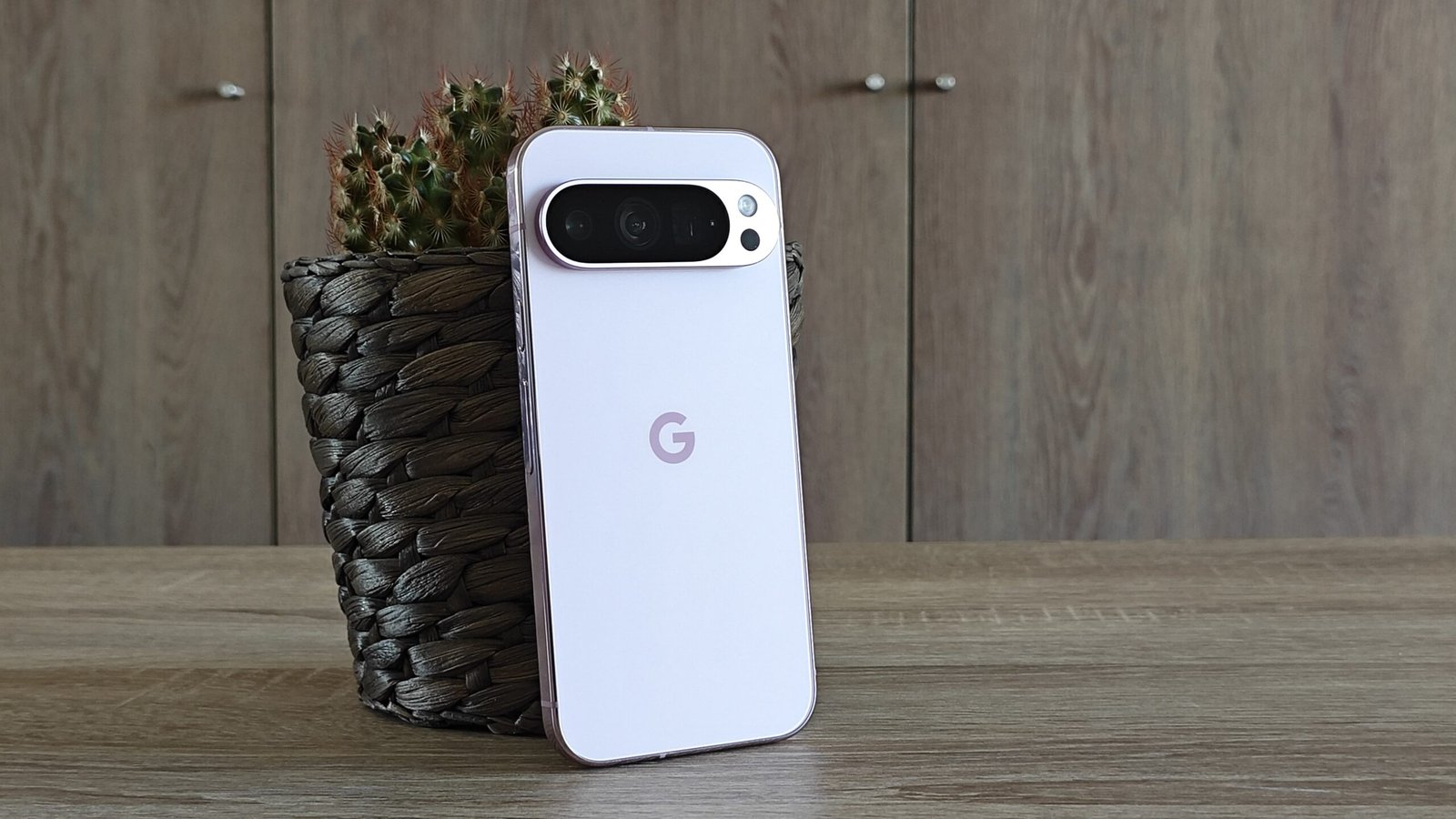You don’t have to be a scientist to enjoy zooming in on things. Mousepad, pen nib or a rogue eyelash: stick anything from your desk under a microscope and you’ll find it looks fascinating when magnified a few hundred times. The world looks very different down there.
But to see all the small things, you normally need a big one. Because of the complex optics required to get a clear picture at micron scale, most quality microscopes demand a hefty slice of desktop real estate. And a good chunk of pocket money, too. Even junior zoomers come with a sizeable footprint.
Think back to your days mucking about with microscopes in the school science lab. The ones with the twisty focus knobs, fiddly slides and lenses that rotate to different zoom lengths. Fun but clunky. Probably not cheap. Certainly not pocket-sized.
The iMicro Q3p changes all of that. Barely bigger than a contact lens, it’s a fingertip accessory which claims to turn any smartphone into a 1200x microscope – simply by sticking to the camera. And it does so for a pledge of just CA$59 (around $43 / £32 / AU$67).
That’s a huge assertion for something so small. Yet it’s also one that’s won the iMicro thousands of backers. My interest piqued by its bold promises, I decided I had to try the Q3p for myself. A few emails later and I had it attached to my iPhone 12, hovering over a drop of coffee, trying to test its microscopic potential.
Scoping out the iMicro Q3p
I say ‘trying’ because the iMicro requires a frustratingly fine touch to get results worth writing about. Perhaps inevitably for something so small, working at such minute scale, the setup is very fiddly. Get it right and your reward is some seriously cool microscopic imagery (more on that below). But you’ll need real patience to reach that point.
Let’s zoom out for a moment. The Q3p is actually the sixth instalment in the iMicro lens line-up, which began with the original iMicro Q back in 2018. Since then, iMicro says it’s received more than 30,000 crowdfunding pledges and manufactured some 60,000 fingertip microscopes. Along the way, it’s refined the proposition with greater zoom, improved packaging and polarized optics.
Each iMicro version has followed the same basic formula. Sized like a coin cell battery, the lens sticks to your smartphone camera using a backing layer with thousands of nano-sized suction cups. This mounting method works with any mobile make or model. It’s also reusable and doesn’t leave a residue when you remove it, which means you can share your iMicro with fellow scopers.
Once the lens is attached to your phone, you simply hold it over a sample with your camera app open. You need a bright light source, the torch on your phone being the obvious answer. Then it’s simply a case of positioning your handset at the right distance from the object that you’re putting under the microscope.
That’s easier said than done. For a clear image, the iMicro has to be situated right up against the sample, almost touching it. With a tight focus window, there’s a very narrow operating margin. Factor in some handheld jerkiness and you’ve got a challenge.
Finding this focal sweet spot is fun when you’re first experimenting with the iMicro. But once you realise that you need to do it each and every time you swap a sample, it soon becomes a bugbear – especially if you’re trying to capture sharp images, which in itself requires a bit of finger Twister. This is a complaint that’s been voiced by users of previous versions and it’s why iMicro ships a focus stand with the Q3p.
Comprised of three laser-cut wooden props, the stand comes flat-packed in the plastic case. Two parts support either side of your smartphone, while the third is designed to raise and lower the base of your phone to ‘focus’ the image by moving the camera relative to the sample. Unfortunately, it’s broadly ineffective.
The maker describes it as a ‘precision-focused stand’ that’s ‘crucial when dealing with the elevated magnification levels of the iMicro Q3p’. It’s right about the latter: using the Q3p does require careful control. But the stand doesn’t offer anything close to precision. It is possible to prop your phone in a position where the subject is in focus, but the main wedge is too crude for fine adjustments.
The three-piece setup is also very easy to knock out of place, which makes it arguably more frustrating than trying to focus handheld. There is, it seems, a reason why most microscopes have movable stages with multiple focus knobs.
Zooming in with the iMicro Q3p
Still, I stuck at it and I’m glad I did. With perseverance, the Q3p delivers on its promise of turning your smartphone into a microscope.
Shipped in a case with the iMicro is a plain backing card, a transparent sheet of scale markers and some fabric swatches to magnify as samples. These work well as a way to get your bearings with the Q3p. The calibration markers don’t just let you measure things: they also make it easier to actually locate your sample when free-handing above it with your smartphone.
Initially, I had visions of walking around the house and magnifying the surface of things by pointing my iMicro-equipped mobile at them. In practise, it doesn’t really work like that. I was able to get a cool close-up shot of my MacBook’s body, but in general I found the best results came by using the plastic case as a sample tray with the scale card inside. Mainly because it kept things contained without blocking ambient light.
The included mesh samples are a good starting point. I found them forgiving to work with because the squares are relatively large and fully cover the scale markers. They also have large tabs attached, which makes them easier to manoeuvre beneath the lens. All of this is helpful: you might think it’s simple to find things at magnification, but I can tell you it’s not. Any reference point is a welcome one and bigger is better while you’re working out what’s what.
Working this way, the Q3p finally started to feed and satisfy the child-like curiosity which surely motivates most of its backers. There rendered large on my iPhone screen were the minuscule strands of mesh sitting beneath the lens. I could inspect the tiny fibres at several-hundred times their actual size, just as promised. All thanks to a little low-profile disc stuck to the back of my phone.
I found it easiest to do this with my iPhone set to video mode. This allowed me to keep the flash permanently on. It also meant I didn’t have to try and hit the shutter button while maintaining the correct focus distance, as I could instead take still frames from the footage later. (There is an official i-Seeing app with digital scale overlays, but this is so glitchy that it’s not even worth covering.)
Once I’d got the hang of the iMicro this way, I was able to experiment with smaller samples: hairs, pencil lead, a piece of aluminium foil. The world revealed by the iMicro was as remarkable as you’d expect, full of hidden details. As the little letter in its name suggests, the Q3p also benefits from polarization. This gives it an advantage when inspecting crystals and minerals, enhancing color and contrast for better definition.
While the quality of images is technically dependent on what phone you have, such is the calibre of modern smartphone camera sensors and lens optics that I’d wager you’ll have pretty much the same iMicro viewing experience with any contemporary handset. You will have to accept significant vignetting, though.
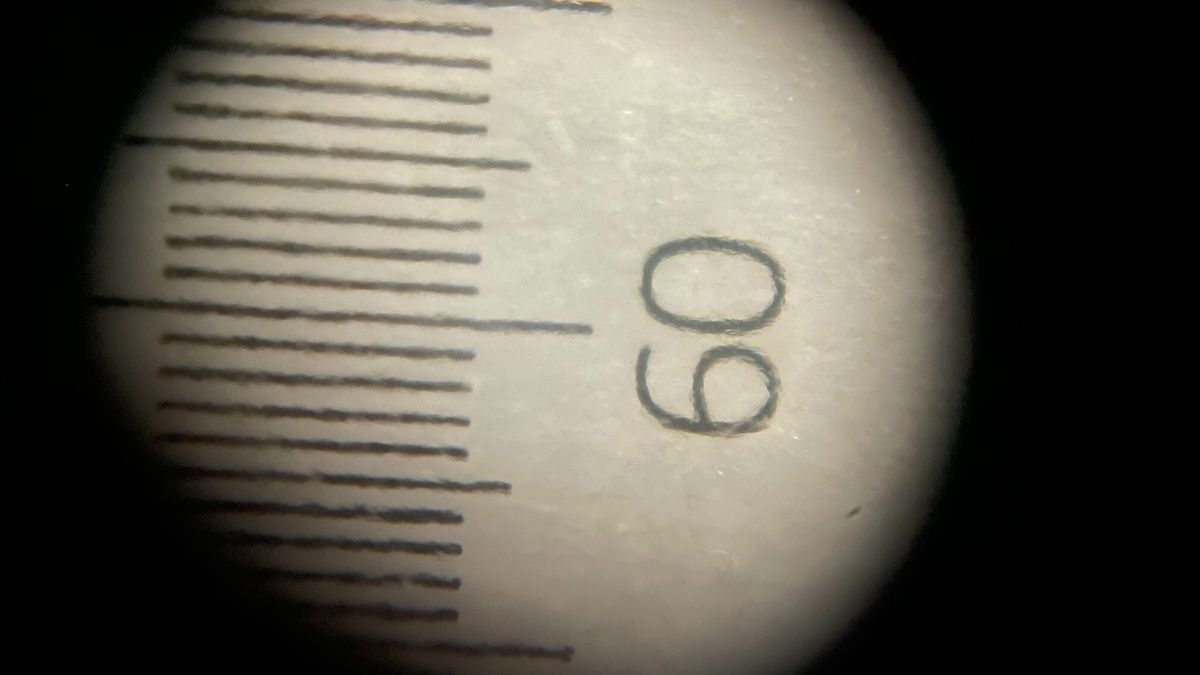
Question marks arise when it comes to the claimed magnification. Officially, the iMicro Q3p is rated at 1200x, which means it can resolve images below a single micron. That’s a range usually reserved for the most powerful desktop microscopes. Anyone with a working knowledge of optics would raise an eyebrow – and rightly so.
A deeper look at that claim reveals some fudging of the numbers. Only part of the zoom range is provided by the lens optics. The rest of the calculation factors in the scaling of the image from the camera sensor to fill your phone screen, as well as the digital magnification if you pinch to zoom on the image. That’s a long way from a genuine 1200x range.
I asked the iMicro team for some clarification. Like the calculation itself, the response was layered: ‘optical magnification alone is not a very meaningful measurement, as it must be considered together with the camera’s lens, sensor and display’. This much is true, but the fact remains that most buyers will use magnification as a benchmark measurement.
The team did confirm that ‘the optical magnification of the lens is approximately 390×’. They went on to say that, ‘in terms of real-world imaging performance, when used with a smartphone, this lens is comparable to a 400–600× high-end compound microscope.’
Based on my experience, I’d say that’s accurate. It’s also mightily impressive for something so tiny. But I can’t escape the feeling that iMicro is slightly mis-selling its microscope by sticking the 1200x label on it.
Looking back on the iMicro Q3p
If that all sounds harsh, it’s because I dislike false advertising and really wanted the Q3p to deliver. Lofty promises aren’t uncommon in crowdfunding, but by claiming the Q3p can deliver 1200x magnification, iMicro has slightly set itself up for a kicking. In real terms, that simply isn’t the case. This isn’t something that can replace a professional microscope, which should perhaps be obvious from the fact that it weighs less than half a gram and costs next to nothing.
It would be better marketed as an optical toy instead of a serious scoping tool. Re-framed as an affordable plaything, I think the iMicro has plenty going for it. A stick-on lens that gives your smartphone the power of 400x magnification? That’s enough to make it entertaining for a few weekends. And it’s probably enough to justify spending CA$59 (around $43 / £32 / AU$67) to give it a go.
Yes, the bundled focusing stand is naff, which means you’ll need to tolerate a lot of wobble (unless you have the world’s steadiest hands). Yes, you’ll need to work out the best combination of camera mode and flash. And yes, even then, there’s an art to capturing sharp stills, which will have heavy vignetting in any case.
But if you buy it knowing all of that, you won’t be disappointed. All told, I came away impressed by the engineering that’s obviously gone into the Q3p. There’s a definite wow-factor here. If anything, the effort of finding focus only adds to the build-up, with a real moment of awe when you first see something up-close and magnified in all its miniature detail on your screen.
Keep your expectations in perspective and you’ll get a lot of joy from the iMicro Q3p. Just don’t go selling your other microscope.

